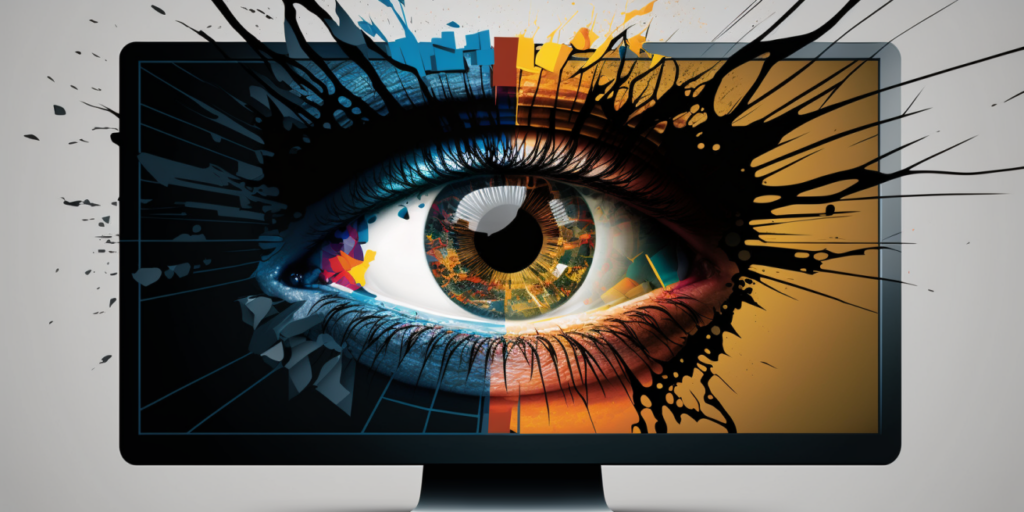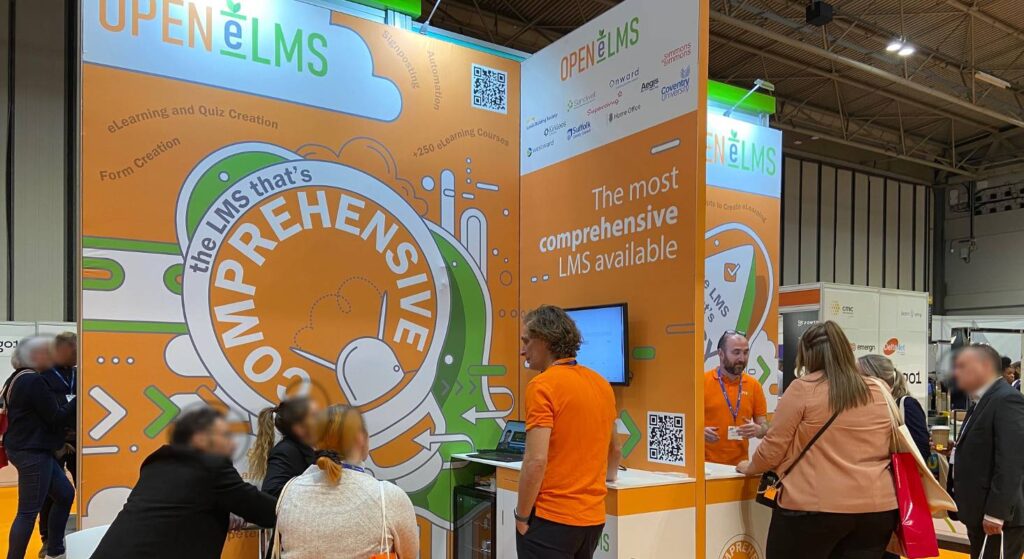openelms.ai – the first elearning designed 100% using AI

Introduction Since the recent renaissance of AI the clock has been ticking to produce a product that creates real eLearning from a text prompt. The technology exists for producing research scripts on any topic, images and video based on that text and AI can now read an image which allow it to select the right animation for each image and place elements in accordance with good design heuristics. openelms.ai – years in the making Open eLMS recognised the potential early and has been developing openelms.ai for a few years. Furthermore the design system is built on it’s online eLearning authoring tool – Open eLMS Creator – which has been pushing the boundaries of what is possible in eLearning design for the last 15 years. This means any AI generated course can be edited after delivery, using a simple drag and drop style interface. How does it work? openelms.ai requires no prior instruction, simply enter your eLearning requirement, select the length of the course (number of slides) and whether you want a quiz at the end. openelms.ai will then get to work and generate the course for you, this will include video presenters, images, animation and background scenes in which you are setting your learning. The system will also design several options for each screen so you can select the most appropriate or, if none of the designs are suitable, you can generate your own using Chat GPT’s own image generator. If any of this sounds complex, don’t worry it’s not. The process should take less than 60 second from start to finish. What does the eLearning look like? The eLearning is an immersive and engaging experience, basing the learning in virtual learning worlds. This is not a presentation or vertical scrolling experience, the learning is closer in feel to an interactive documentary. In an independent study carried out by the UK’s largest provider of social housing, this eLearning was found to have approval rates of 99%. Furthermore the eLearning has all the features you would expect in any eLearning such as interactive quizzes and knowledge checks. And this is only the start, openelms.ai will be introducing customised computer generated presenters so you can star in your own eLearning and video production elements as the AI technology evolves. How can I access openelms.ai for free? openelms.ai are offering a free version of this system at the launch. Simply go to www.openelms.ai and register to generate your eLearning. The eLearning course can then be downloaded and ran within any Learning Management System. We implore you to give it a go, it will take 60 seconds to change your approach to eLearning creation for life. Access Details www.openelms.ai Further Information openelms.ai – the first eLearning designed 100% using AIopenelms.ai – an early view!Learning News: 5 Artificial Intelligence tools you need to start using now to build eLearning
openelms.ai – the first elearning designed 100% using AI

openelms.ai has recently created the world’s first eLearning courses designed entirely using AI from a single line of text. These short courses took a matter of seconds to produce from a single line of text. The eLearning is available for preview on their website, and they provide a glimpse of the capabilities of the OpenElms.ai platform. The eLearning consists of 7 screens and are for demonstration purposes, the finished system will allow creators to produce courses of any length. The AI-designed courses are comprehensive, easy to navigate, and engaging. The courses utilize a range of multimedia, such as videos, infographics, and interactive quizzes, to enhance the learning experience. The system is due for release at the end of April 2023.
openelms.ai – an early view!
https://youtu.be/e1_s699cBE0 openelms.ai is an eLearning creation system which delivers learning courses of breathtaking quality from a single line of text. This Adobe Captive / Articulate killer is a read game-changer for education and corporate training. The system is due for release at the end of April 2023.
How we are using AI to Create eLearning
Artificial Intelligence can create elearning in seconds – we will show you how This video demonstrates the unique systems and services used by Open eLMS to produce truly engaging e-learning. See www.openelms.ai for further details. Other links of relevance include: MidJourney – excellent image maker Dalle-2 – Open AI’s alternative Chat GPT – need we say any more? D-id – talking heads for eLearning descript – voiceover using text in your own voice openelms.ai – eLearning with a single line of text
Is AI the great EdTech disrupter?
In this video, Emil Reisser-Weston – Open eLMS Product Director – discusses how AI will shape the EdTech industry with references to openelms.ai.
The advantages of AI for elearning creation

Introduction Artificial Intelligence (AI) has been rapidly transforming various industries, and eLearning is no exception. With AI-powered tools, elearning content creation has become faster, easier, and more personalized than ever before. In this article, we will explore the benefits of AI in eLearning content creation and how it can improve the learning experience for students. Personalized Learning One of the most significant benefits of AI in eLearning content creation is personalized learning. With AI-powered tools, educators can create personalized content based on a student’s learning style, preferences, and performance data. This allows students to learn at their own pace and level, improving their engagement and overall learning outcomes. Personalized learning also helps educators identify knowledge gaps and provide targeted interventions to improve student understanding. Increased Efficiency AI-powered eLearning content creation is more efficient than traditional methods. It can create content quickly, accurately, and consistently, allowing educators to focus on other aspects of their job, such as teaching and engaging with students. This efficiency saves time and reduces costs, making eLearning more accessible to a broader audience. Elearning can be created in seconds using openelms.ai Enhanced Engagement AI-powered eLearning content creation can significantly enhance student engagement. With interactive content, such as videos and simulations, students are more likely to retain information and engage with the material. AI-powered content can also adapt to a student’s performance, providing feedback and adjusting the difficulty level of the content accordingly. This personalized approach can improve student motivation and interest in learning. Improved Accessibility AI-powered eLearning content creation can improve accessibility for students with disabilities. For example, text-to-speech technology can convert written content into audio format, making it accessible to students with visual impairments. This technology can also benefit students with dyslexia or other learning disabilities, providing them with alternative ways to learn and engage with the material. All openelms.ai courses include voiceovers and video presenters in up to 27 different languages Consistent Quality AI-powered eLearning content creation provides consistent quality across all content, regardless of the amount produced. The use of AI-powered tools ensures that content is created in a standardized format and is free of human error, ensuring high quality and accuracy. This consistency is essential in eLearning, where learners expect high-quality content that is easy to understand and learn from. AI elearning creation tool – openelms.ai – produces elearning of consistent quality Cost Savings AI-powered eLearning content creation can be cost-effective for educational institutions. The use of AI-powered tools reduces the need for human labor, saving time and costs associated with traditional content creation methods. Additionally, AI can generate content at a faster pace than humans, enabling educators to create more content in less time. Conclusion AI-powered eLearning content creation has numerous benefits, including personalized learning, increased efficiency, enhanced engagement, improved accessibility, consistent quality, and cost savings. With AI-powered tools, educators can create engaging and effective eLearning content that meets the needs of individual learners, providing an optimal learning experience. As AI technology continues to evolve, we can expect to see even more innovative solutions for eLearning content creation.
Using AI to write elearning scripts

AI models such as Open AI’s ChatGPT and Google’s Bard are powerful language models that have been trained on a vast corpus of text, which makes it well-suited for writing e-learning scripts. Sophisticated machine learning algorithms allow AI to ‘understand’ language and structure used in educational content, making it capable of generating clear, concise, and informative e-learning scripts. In layman’s terms, what AI does is predict your next word (similar to autocorrect on your word processor) but it does it very, VERY, well. So well in fact, that the output it gives is often flawless. Here for an example is a sonnet written by ChatGPT about Open eLMS and how it can create elearning using AI: Oh, Open eLMS, fair EdTech company, Whose AI-generated e-learning courses bright, Doth give students worldwide opportunity, To learn, to grow, to spread their minds’ great height. Through wond’rous use of language processing tech, A single line of text becomes a course, The material flows smooth without a wreck, And all who study find they can endorse. The student may be from the farthest shore, Or close at hand within their home’s four walls, But thanks to thee, they can pursue and more, Their passion for knowledge, without any stalls. Thus, Open eLMS, through thy efforts grand, Doth spread the light of learning through the land. This took far less than a second to ‘compose’ – not exactly bard-like (apologies to Google) but still, very impressive for a first go. One of the key advantages of using AI for e-learning development is its ability to generate content quickly and efficiently. The model is capable of generating large amounts of high-quality text in a short period, which can be particularly helpful when creating e-learning content on tight deadlines. Additionally, AI can generate content in multiple languages, making it an excellent option for those who need to produce e-learning content for a global audience. Another benefit of using AI for e-learning scripts is its flexibility. The model can be customized to the specific needs and preferences of its users. For example, AI can adjust the tone, complexity, and style of its writing to match the audience and purpose of the e-learning material. This means that the model can produce scripts that are appropriate for a variety of learners, including those who may have limited knowledge of the subject matter. Moreover, AI’s ability to learn and adapt to new information makes it an excellent tool for creating e-learning scripts. As more content is generated and input into the model, it becomes better equipped to generate high-quality text that is both informative and engaging. This means that AI can help e-learning content creators stay up-to-date with the latest research and best practices in their field without repeated investigation and rewriting of the content. In conclusion, AI is already being used to write e-learning scripts and results have been very impressive. AI generated script with background images AI is not however limited to text generation (it created the image for this article for instance.) Open eLMS is currently going one step further and integrating AI into the design process, whereas content and design are generated for the elearning at the same time. Early results have been very impressive, watch this space for the latest on Open eLMS AI.
5 New jobs in EdTech for the AI revolution

If you have yet to see the impact of Artificial Intelligence now on EdTech, in the coming months you will see a dramatic change in Q1 and Q2 2023. The change is already happening swifter than most had imagined; with 6 weeks ChatGPT has gone from a party trick for geeks to dominating the headlines around the world. AI is not going away, but how will it affect the job market within the EdTech sector? Open eLMS are implementing AI in everything we do and here are five new jobs that we have identified as being high in demand in the coming year: 1. AI integration consultant: As AI continues to revolutionize the education sector, organizations are looking for individuals with expertise in AI and education to help integrate these technologies into their systems. This role is not necessarily technical, what is required is a firm understanding of client needs and knowledge of the potential solutions available. 2. Personalized Learning Coach: Personalized learning is a growing trend in education, and AI is playing a significant role in making this possible. Personalized learning coaches can use AI-generated insights to build learning specifically tailored to an individual’s needs. Open eLMS AI is doing this with AI, building an entire curriculum of learning based on text-based queries. A good knowledge of the training needs and good writing skills is needed for this role. 3. Virtual Environment Creator: As AI tools add immense graphical power to EdTech development, there is the need to up the game. The elearning suppliers will sell in a years’ time will be incomparable to the learning materials sold presently (think more PlayStation 5 than PowerPoint). To this end designers will need to use the AI to create engaging and interactive virtual environments using technologies such as Unreal Engine and AI Example Open eLMS environment 4. Educational Data Scientist: With the increasing amount of data generated in the education sector, there is a growing demand for professionals who can analyze and interpret this data. Educational data scientists use machine learning algorithms and statistical techniques to analyze student performance data, providing insights into areas of improvement and identifying trends in student behavior. Learning Management Systems will be the data source for driving management decisions via the insights bought through AI. The Educational Data Scientist should have a good understanding of the business and be aware of what questions to ask to affect real change within an organisation. 5. AI-assisted Instructional Designer: AI-powered technologies are being used to create more personalized and effective learning experiences. AI-assisted instructional designers use AI to design instructional materials that cater to the unique needs of each student, ensuring that they receive a customized learning experience. Such designers will need to focus on information design and use the AI tools to develop content. There will be more emphasis on the requirement for checking the content as AI assisted learning development does a lot of the heavy lifting. In conclusion, AI is creating new job opportunities in the Ed Tech sector for human beings who possess the right skills and expertise. These jobs offer a chance to make a difference in this daunting and AI driven future that we all face today.
World of Learning Exhibition

Many thanks to everyone who came and saw us at the WOLCE show in Birmingham UK today. It’s great to get such a positive response from the industry. A common theme was “you’re so far ahead of the competition”. The comprehensiveness of what we do – a Learning Management System with integrated forms, courses and course editor – was a real surprise to many and it’s great to be able to say “yes” to any queries. We will continue to strive to improve and enhance, but its rewarding to see how our designers have got it right over the last few years by listening to you!
eForms, eSignatures and the LMS

The International Data Corporation (IDC) – the premier global provider of market intelligence – forecasts that spending on e-signature technology will grow annually by at least 20% over the next five years. e-signature solutions and form creation provide dramatic cost-effective productivity improvements, for instance one global bank has reduced the average time for circulating and approving procurements from 2-3 days to minutes. So how is this relevant to Learning Management Systems such as Open eLMS? Legal Compliance Learning is often the fundamental step in any legal compliance system. Companies need proof that learners have attested to having completed any compliance training or carried out certain tasks prior to their accreditation. Standards Conformity ISO standards require personnel to sign off on having carried out the necessary training as well as having read company policies and procedures in order to gain adherence to that standard. Personnel Management Learning Management Systems such as Open eLMS incorporate personnel management features such as 360 feedback, review meetings etc. Within these meetings it is necessary to complete forms and sign them off to all parties satisfaction. Onboarding Learners often need to supply a wealth of information prior to starting induction training or a structured learning programme etc. Apprentices for instance need to complete an Individualised Learner Record comprising of over 200 fields. A structured form filling in process which validates individuals via photo recognition and passport/driving licence ID validation is a vital component of a smooth onboarding process. Open eLMS Forms is a completely customisable solution for: Legal Compliance Standards Compliance Personnel Management And Onboarding Open eLMS Forms automatically fills in forms from data already collected – thereby saving time and money. Furthermore it ensures that the right forms are emailed to the right people at the right time, the workflow, forms and documentation are customizable to suit each company’s needs. To find out how we can tailor eForms to work for you please contact sales@elearningwmb.com to discuss your ideas further.
